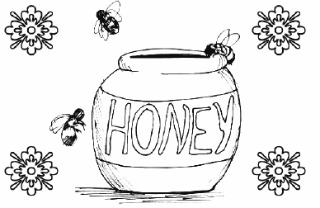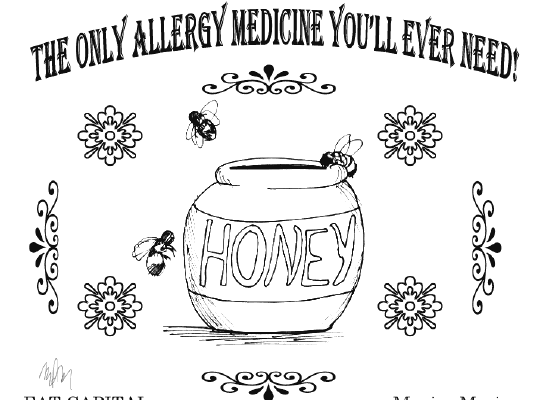The Fat Diaries: Is Honey the All Natural Allergy Fix?
 It’s allergy season again: trees are busy making baby trees and humans are suffering. This year, I'm trying something new to ward off my symptoms.
It’s allergy season again: trees are busy making baby trees and humans are suffering. This year, I'm trying something new to ward off my symptoms.
If you’re like me, and like about half the population of the Piedmont Basin, this last week has been a rough one for you. It’s allergy season: trees are busy making baby trees and as a result humans are suffering.
Last year we had an allergy season the likes of which nobody had seen before. I’ve been an asthmatic and a seasonal allergy sufferer in Virginia for the better half of twenty years and had never encountered allergies as bad as last year’s — neither had doctors or botanists either. When the pollen count jumps from the tens to the thousands in two years people sit up and take notice.
Last year, my husband and about half my friends were diagnosed with severe seasonal allergies after never having them before -- and they weren’t alone. A flood of people went to their local doctors for runny noses, blurred vision, hacking coughs, insomnia, rashes, earaches, migraines, and even depression (it can be a symptom!) and been diagnosed with seasonal allergies.
When my allergies flare up it’s very bad news. It aggravates my asthma, making me short of breath and light headed; it blocks my sinuses with terrific pressure that can lead to sinusitis; it can also make me lose my voice as it did this weekend. It’s terrific timing too, since I had an audio-recording to do this week and a book reading this coming weekend (bleh). I’ve been prescribed pills, eye-drops, nose-sprays in addition to my usual regimen, and with that much medicine in my system I sometimes have trouble remembering if I’m wearing shoes when I leave the house.
It makes me tentatively wonder what this year has in store for us, pollen-wise. After an incapacitating Sunday and Monday, I’ve been trolling the internet and books for addition allergy solutions.
The first thing to crop up was immunotherapy. This has traditionally been done with small injections of allergy triggers, administered to a patient until their body builds up a resistance. I’d always had trouble with allergy shots: with my already erratic health I ended up missing a LOT of therapy appointments, which defeated the purpose. I’d also soured on the experience since the allergy doctor I went to as a kid was sued for malpractice shortly before he grabbed all his cash (and a few other people’s) and ran away to Mexico.
Ruling out injections, I noticed another item popping up under immunotherapy: honey. According to some experts, (and the studies are still pending) eating two tablespoons of local honey per day can help a person fight off seasonal allergies. It kind of makes sense. The local bees visit the local flowers that are driving you nuts, make the honey, then you deliver it to your body in tiny doses every day until you build up a tolerance. It wouldn’t work as well with store-bought honey because a) the pasteurized honey kills a lot of the pollen and other impurities in raw honey and b) honey made outside of your geological area will contain different types of pollens than the pollens in your own backyard.
I asked my doctor about the honey therapy. He said it sounded plausible and that I was free to try it — it couldn’t hurt. But he also warned me that if I had an allergic reaction to the honey right off the bat, I should stop. There was a possibility that the local pollens in the honey might actually trigger more allergy symptoms. My husband Joe said he had a friend who could hook us up with a local beekeeper, so I decided to try it. We use a lot of honey around here anyway (peanut-butter-and-honey sandwiches being a staple food) and I’m always interested in supporting local farmers and growers anyway.
The idea of taking 2 teaspoons a day was daunting. I like honey as much as the average bear, but that’s a bit too sweet for my palate. Still, I screwed my courage to the sticking stuff and gave it a go; for the last six days I’ve been taking honey in hopes that my suffering will be eased a notch a year. I found I liked it best when my two teaspoons were followed by a hot cup of tea.
The jury’s still out on whether it’s actually working or not. My allergies have been manageable in the last few days (beyond mild asthma attacks and congestion) but that might be due to my new antihistamine nose-spray more than the honey. I’ll keep the experiment going this spring, making sure to check the pollen count to get a better picture overall.
I’ll be honest: I’m not expecting miracles. I’m not doing this with the hope of frolicking through a field of ragweed and goldenrod with a crown of grass in my hair — that’s just not in the cards. I just want to reach a point, in the distant flying-car future, where I can drive my kids to school without needing to use my inhaler or waking up without my head feeling like it’s going to fall on the floor. If I’m not profiting from this arrangement, at least the bees are.
Tweet


